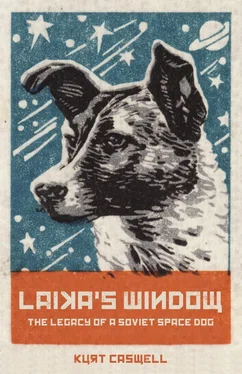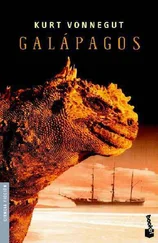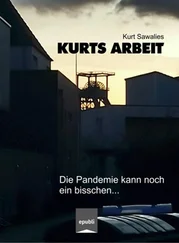The space dogs that had gone beyond the Karman line before Laika had lingered in microgravity for only a few minutes. With Laika in orbit indefinitely, the ground team could investigate the effect of microgravity on a living being over time. The team needed at least twenty minutes of data from Laika’s sensors to make an initial assessment. The ground stations could only receive data for fifteen minutes before Sputnik II flew out of range. It would have to do. Using that data, the team determined that Laika’s vitals had returned to normal, oxygen levels in the capsule were adequate to support life, and the capsule did not lose pressure after entering the vacuum of space. Laika’s flight had just proven that microgravity was tolerable for a human being in orbit. What the limits were no one yet knew, but Korolev and his team were now confident that they could build a rocket and a capsule that could take a man safely into orbit. One day Earth orbit would teem with satellites and cosmonauts working on orbital space stations, but for now it was Laika alone who was sailing in the resolution of the stars.
¤
When I spoke with American astronaut Donald Pettit, I asked him about the experience of rocket flight. What did it feel like to fly? An astronaut experiences a great deal of noise and vibration, he said, but from inside a space suit that noise and vibration is minimized. In a Soyuz-type rocket (the kind of rocket Laika flew in), the force against the body is about 3–4g, Pettit told me. The result, he said, is that “you’re pushed pretty hard into your seat.” But you are pushed pretty hard into your seat on an increasing scale as the rocket accelerates and then only for about eight minutes, or until the rocket enters microgravity. That 600 pounds is reduced suddenly and dramatically, but it is not reduced to zero. The term “zero gravity” is misleading because there is plenty of gravity in orbit. If there were no gravity in orbit, there would be no orbit at all. In zero gravity, a satellite or the ISS would simply fly off into the great unknown, the moon would not be the Earth’s constant companion, and the solar system, even the galaxy itself, would not hold together. Gravity on a spacecraft in orbit is about 88.8 percent of what it is on Earth. The reason astronauts and objects float in Earth orbit is not because there is no gravity. They float because the spacecraft and everything in it is falling around the Earth at the same velocity. To be in orbit is to be in a continuous state of free fall, the spacecraft and everything in it, falling back to Earth. But in orbit a spacecraft’s velocity is in equilibrium with gravity so that it will never reach the surface. The spacecraft falls around the Earth, and it just keeps falling.
Human astronauts ride into space positioned on their back because it’s easier to breathe. They can inflate their lungs upward into the empty space above them. Lying on their bellies doesn’t work, because under the force of 3 or 4g, astronauts would have to inflate their lungs by pushing the now tremendous weight of their body upward, again and again, for eight minutes. It would be like trying to breathe while lying on your belly with two or three people sitting on top of you. An astronaut’s blood can flow almost normally while positioned on his or her back, as the force of acceleration is acting laterally on the body. If the body is vertical to the force of acceleration (toe to head, or head to toe), blood either rushes away from the brain, which can cause a loss of consciousness, or it rushes to the brain, which can cause cerebral hemorrhaging and possibly death.
In The First Steps , Ivanovsky describes film footage of rats riding into space on a rocket. “While taking off and accelerating, rats slow down, their legs are wide apart, their heads go lower and lower, and finally hit the floor,” he writes. “The g-force presses an animal down to the floor, and it stops moving, its muscles cannot cope with the increased weight.” He goes on to say that a “few seconds later the animal suddenly takes off from the floor and for a moment hangs somewhere in the middle of the box. No support! The rat begins to move randomly in the box. It goes from turning around its axis to flying into the corner, from spinning, like a spindle, to somersaulting.” As weight is a primary indicator of up and down for all terrestrial animals on Earth, the rats lose “the sense of up and down, and [have] no points of support and no signals from legs and tail are being delivered. Only the vision continues on normally, but at first [they fail] to deal with the chaos of other perceptions.”
Laika wore a flight suit to keep her sensors in place, but she did not wear a space suit. Her sealed capsule inside Sputnik II , however, helped minimized the noise and vibration from the rocket. These sensations were familiar to her too, as she had trained to tolerate them. To avoid injury during the rocket’s ascent, Laika was secured with restraining chains while lying on her belly. Lying on her back would have been the best way to endure the g-force of acceleration, but as Pettit observed, dogs “are not meant to lie on their back. Dogs lie down [on their belly], and a dog isn’t used to having a lot of force on their belly either. The geometry of a dog is not something that could take a lot of force. I think it would probably be more unpleasant for a dog [to ride a rocket into space] than it would be for a human being.”
The acceleration of the rocket, then, put a lot of force on Laika’s belly, making it hard for her to breathe. This is why her respiration increased so dramatically. She was probably taking rapid, shallow breaths, trying to keep air in her lungs as the rocket pressed up beneath her. Once she entered microgravity, the noise and vibration and the tremendous force of acceleration vanished. She would have felt much more at ease, but for her unbearable thirst.
¤
Imagining Laika up there in her spacecraft, confined in that small capsule, makes me feel lonely. This loneliness is my loneliness, of course, but I am not the only one to feel it. Many of the people I spoke with in working on this book were quick to inquire about Laika’s loneliness and to express their own loneliness when faced with the thought of her up there alone in space, with the thought of her dying in space. Why do we feel this way when we imagine Laika spinning across the roof of the world, forever interred in that metal can?
Lots of people surrender to animal emotions, dog emotions especially. Can we know how a dog feels when we think of them as feeling like us? In fact, we depend on them to accede to the way we feel, even as we cast our feelings upon them. Knowing this, it is still worth asking: Did Laika get lonely in her spacecraft? Was Laika lonely as she died? Can we say, even, that dogs feel loneliness? Or did Laika feel a sense of purpose in the way that a working dog can? Or perhaps she felt nothing at all. We know that dogs can feel, that they have feelings. Anyone who has ever lived with a dog knows this. We know too that our dogs respond to our feelings. They sense our anger at them, and our anger at each other. Dogs know when people are fighting, when they are in conflict and distress. Dogs pick up these feelings and are then equally in distress. Dogs know when people are happy and at their ease. Dogs then are happy and at ease. A dog knows when another dog is in pain, or when we are in pain, when we are suffering from a wound in the body or a wound in the heart. Our dogs are drawn to our wounds, drawn to us in the center of our grief, drawn to our tears. It follows, then, that dogs might feel lonely.
In a study published by the Association for Psychological Science, social psychologist John Cacioppo of the University of Chicago and his team assert that “loneliness is not a uniquely human phenomenon.” Animals of various kinds, especially social mammals, do in fact experience loneliness. Their loneliness, and ours, can be measured by physical responses in the body, namely by “a significant increase in plasma cortisol,” a stress hormone. And why do animals feel lonely? Because loneliness is an adaptation, writes Cacioppo; it “represents a generally adaptive predisposition in response to a discrepancy between an animal’s preferred and actual social relations that can be found across phylogeny.” Loneliness, he writes, “has evolved as a signal to change behavior—very much like hunger, thirst, or physical pain.” In manageable doses, then, loneliness triggers a response in the individual to establish or repair social relationships. Social animals need each other, and so loneliness can help keep a group or pair tightly bound, which betters each individual’s chances of survival. As an adaptive predisposition, loneliness has been here a long time; it was here on Earth before humans.
Читать дальше












